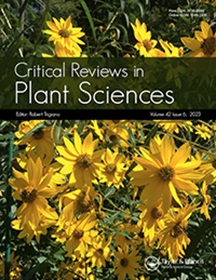叶面施肥:提高植物耐盐性的一种潜在策略
IF 4.9
2区 生物学
Q1 PLANT SCIENCES
引用次数: 0
摘要
摘要土壤盐渍化是全球范围内影响农业生产力的重要非生物胁迫因素。长期以来,研究人员一直在尝试对生长在受盐影响的土壤上的作物施用肥料,以改善作物的生长。虽然施用肥料的技术多种多样,但叶面施肥可以直接通过叶片向植物提供必要的营养,是提高植物耐盐性的一种潜在技术。本文综述了叶面施肥提高耐盐性领域的最新进展。我们特别研究了通过叶面施肥增加植物耐盐性的过程,以及与该技术相关的问题和可能性。我们还讨论了经评估的改善耐盐性的商业叶面肥料,以及它们在多大程度上被农业社区接受,以广泛使用这种营养补充方法。详细讨论了一系列施肥策略,包括叶面补充和以土壤为基础的方法,特别强调通过叶面施用必需营养素。此外,我们还强调有必要进行更多的研究来提高营养成分,吸收效率和给药策略。因此,叶面施肥有可能成为提高咸水条件下作物生产力的常用策略。关键词:必需矿质养分叶面施肥植物生长耐盐性提高土壤盐碱度提高产量感谢哈伦大学提供数字资源。作者的贡献两位作者共同构思和组织稿件;CK起草了最初的版本,而MA批判性地评估、编辑和完善了内容。披露声明作者未报告潜在的利益冲突。本文章由计算机程序翻译,如有差异,请以英文原文为准。
Foliar Fertilization: A Potential Strategy for Improving Plant Salt Tolerance
AbstractSoil salinity is a significant abiotic stressor that inhibits agricultural productivity globally. Researchers have been trying for a long to apply fertilizers to crops growing on salt affected soils so as to achieve improved crop growth. Although a variety of techniques are in vogue to apply fertilizers, foliar fertilization, which may provide plants with necessary nutrients directly through their leaves, is a potential technique for improving plant salt tolerance. This review outlines recent developments in the field of foliar fertilization for increased salt tolerance. We particularly examine the processes that increase plant salt tolerance by foliar fertilization, as well as the problems and possibilities connected with this technique. We also discuss the commercial foliar fertilizers that have been evaluated for salt tolerance improvement and up to what extent they are receptive by the farming community for the widespread use of this approach of nutrient supplementation. A range of fertilization strategies, including foliar supplementation, and soil-based methods, with a particular emphasis on essential nutrients applied through foliage, is discussed at length. Moreover, we also underline the necessity for more studies to enhance nutrient composition, absorption efficiency, and administration strategies. Thus, foliar fertilization has the potential to become a commonly used strategy for boosting crop productivity in salty conditions.Keywords: Essential mineral nutrientsfoliar fertilizationplant growthsalt tolerance enhancementsoil salinityyield improvement AcknowledgementsThe authors express gratitude to Harran University for providing access to digital resources.Authors contributionsBoth authors collaboratively conceived and structured the manuscript; CK drafted the initial version, while MA critically evaluated, edited, and refined the content.Disclosure statementNo potential conflict of interest was reported by the author(s).
求助全文
通过发布文献求助,成功后即可免费获取论文全文。
去求助
来源期刊
CiteScore
12.90
自引率
1.40%
发文量
15
审稿时长
>12 weeks
期刊介绍:
Critical Reviews in Plant Sciences focuses on presenting in-depth and up-to-date reviews of timely and/or cutting-edge subjects in the broad discipline of plant science, ranging from molecular biology/biochemistry through the areas of cell biology, plant pathology and physiology, genetics, classical botany, and ecology, to practical agricultural applications. Articles in the journal provide an up-to-date literature base for researchers and students, pointing the way towards future research needs. The journal is also a significant source of credible, objective information to aid decision makers at all levels.

 求助内容:
求助内容: 应助结果提醒方式:
应助结果提醒方式:


